MARTIN DAVID "MARTY" ROBBINS - 09/26/1925 - 12/08/1982
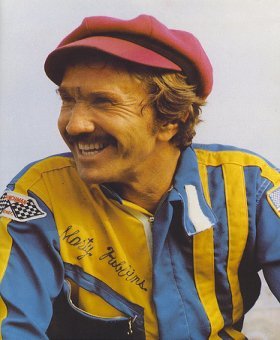
Marty loved NASCAR racing and as he had the funds to do so, he raced occasionally. His cars were built and maintained by Cotton Owens. Marty Robbins ran typically at Talladega Superspeedway, Daytona International Speedway, and many other tracks. In 1983, one year after Robbins' death, NASCAR named the Nashville Fair Grounds race the Marty Robbins 420 in honor of him. Robbins was born in Glendale, a suburb of Phoenix, in Maricopa County, Arizona. He was reared in a difficult family situation. His father took odd jobs to support the family of ten children. His father's drinking led to divorce in 1937. Robbins left the troubled home at the age of 17 to serve in the United States Navy as an LCT coxswain during World War II. He was stationed in the Solomon Islands in the Pacific. To pass the time during the war, he learned to play the guitar, started writing songs, and came to love Hawaiian music. After his discharge from the military in 1945, he began to play at local venues in Phoenix, then moved on to host his own show on KTYL. After Little Jimmy Dickens made a guest appearance on Robbins' TV show, Dickens got Robbins a record deal with Columbia Records. Robbins became known for his appearances at the Grand Ole Opry in Nashville, Tennessee. In addition to his recordings and performances, Robbins was an
avid race car driver, competing in 35 career NASCAR races with six top 10 finishes, including the 1973 Firecracker 400. In 1967, Robbins played himself in the car racing film Hell on Wheels. Robbins was partial to Dodges, and owned and raced Chargers and then a 1978 Dodge Magnum. His last race was in a Junior Johnson-built 1982 Buick Regal in the Atlanta Journal 500 on November 7, 1982, the month before he died. He ran many of the big super speedway races including Talladega Superspeedway in 1972, when he stunned the competition by turning laps that were 15 mph faster than his qualifying time. (The video above also covers this story) After qualifying what happened was that they told NASCAR they had carburetor trouble and got permission to switch them. Then they pushed the car to the starting line to get it past inspection on race morning. When they fired it, it blew all kinds of black smoke for a few seconds. When it cleared, the car began to roar. Robbins would motor up through the field, and as he passed the big name drivers like Cale Yarborough, Richard Petty, Bobby Allison, etc. He would see the shock and surprise on their face to see him running up front with them.
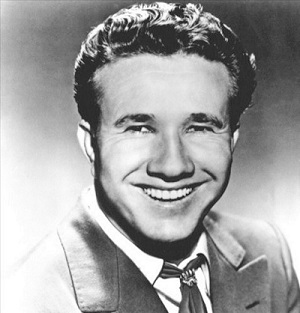
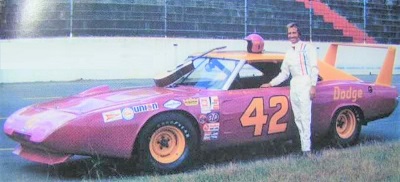
1970 Cup ride
Then he'd wave and motor on up ahead. David Pearson and Buddy Baker were running away with the race. Robbins took the lead. He would run hard a few laps, and then back off a few laps. In the middle of the tri-oval Baker passed Robbins, by the time Baker was in turn #1 he was 400 - 500 yard lead on Marty. All of a sudden Robbins floored it and by time they entered turn #3 Robbins was all over Bakers back bumper. Robbins had never driven that fast before and has stated in several interviews that he wanted to pass the leaders on the front stretch so
everyone could see it. - But he had never driven that fast and wasn't sure if the car would turn at that speed, and if he didn't make it he'd end up at Daytona Beach. After the race, NASCAR tried to give him the Rookie of the Race award, but Robbins would not accept it, admitting he was illegal because he "just wanted to see what it was like to run up front for once." Another funny story involving Robbins happened when he was racing in the Nashville 420 Cup race. By now Robbins was a headliner on the Grand Ole Opry, and made regular appearances. Often being the shows closing act. One Saturday night, Robbins was running very well in the Cup race and being competitive. He suddenly pulled into the pits and reporters rushed to
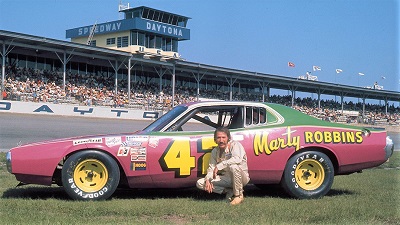
Daytona 1973 - finished 8th
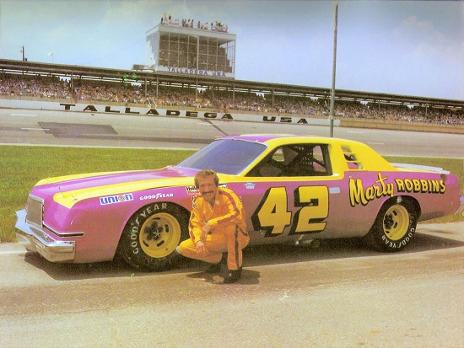
1979 Talladega
see what malfunction he had with his car. One reporter asked "Marty, Marty, what put you out of the race. Did the motor blow up". Robbins just looked at him and smiled saying, "Oh the car..?, nothing wrong with it at all. I have to close out the show at the Grand Ole Opry, and if I don't leave now I will be late". Robbins typically ran purple and yellow cars bearing either number 42 or number 22. He typically ran Dodge Daytona's or Fords. His final race car, a 1978 Dodge Magnum, was superbly restored and donated to the Talladega Museum by his family, and was displayed there from 1983 to 2008. Robbins raced because he wanted to. He obviously did not need the money. He needed the enjoyment. But the pedestrian nature of his racing career did not mean he was notrespected as a driver. Perhaps Buddy Baker paid him the extreme compliment. "I never thought of Marty Robbins as a country and western singer," Baker said. "I thought of him
as a driver." Robbins was often herd to say, "I'm not a singer who races. I'm a racer who sings." As a CUP competitor Robbins ran in 35 CUP events, most all of them on Super speedways. He had seven top 10 finishes, with a seventh place finish in the Southern 500 in 1971, and a ninth place finish in 1972. He finished eighth in the 1973 Fire Cracker 400, with a career best finish of fifth in 1974 in the Motor State 360 at Michigan in 1974. (During the fuel crisis NASCAR races were shortened by 10% to save fuel... so this is why this is a 360 mile race instead of the usual 400 mile event). As a musician and songwriter, Marty Robbins had almost 100 songs that made the country charts. More than a dozen made it to No. 1. His first No. 1 in 1956, was Singing the Blues. And it stayed at the top of the charts for 13 weeks. For old-time country music fans, Robbins is best known for his hits: “El Paso,” "My Woman, My Woman, My Wife," "Devil Woman"and “A White Sport Coat.” Robbins won the Grammy Award for the Best Country & Western Recording 1961, for his follow-up album “More Gunfighter Ballads and Trail Songs,” and also scored a Grammy Best Country Song in 1970, for "My Woman, My Woman, My Wife.” Robbins was named "Artist of the Decade" (1960-69) by the Academy of Country Music, was elected to the Country Music Hall of Fame in 1982, and was given a Grammy Hall of Fame Award in 1998 for his song "El Paso." He had a total of more than 30 Number 1 country hits. Some info from WikiPedia
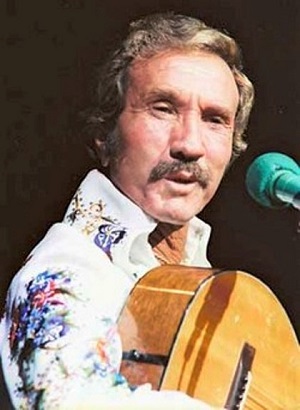
All Photos copyright and are property of their respective owners
